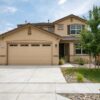When we talk about Reno real estate trends with our clients, friends, and families, they continue to ask the same question: “Is the market going to crash?”
Our short answer? We don’t have a crystal ball, but we believe it’s doubtful that we will see a dramatic market adjustment like the 2008 Great Recession. Here are three key fundamentals that explain why we don’t think the northern Nevada real estate market will crash.
Reno Real Estate Trends: 3 Reasons Why We Don’t Think The Market Will Crash
-
More strict and regulated lending
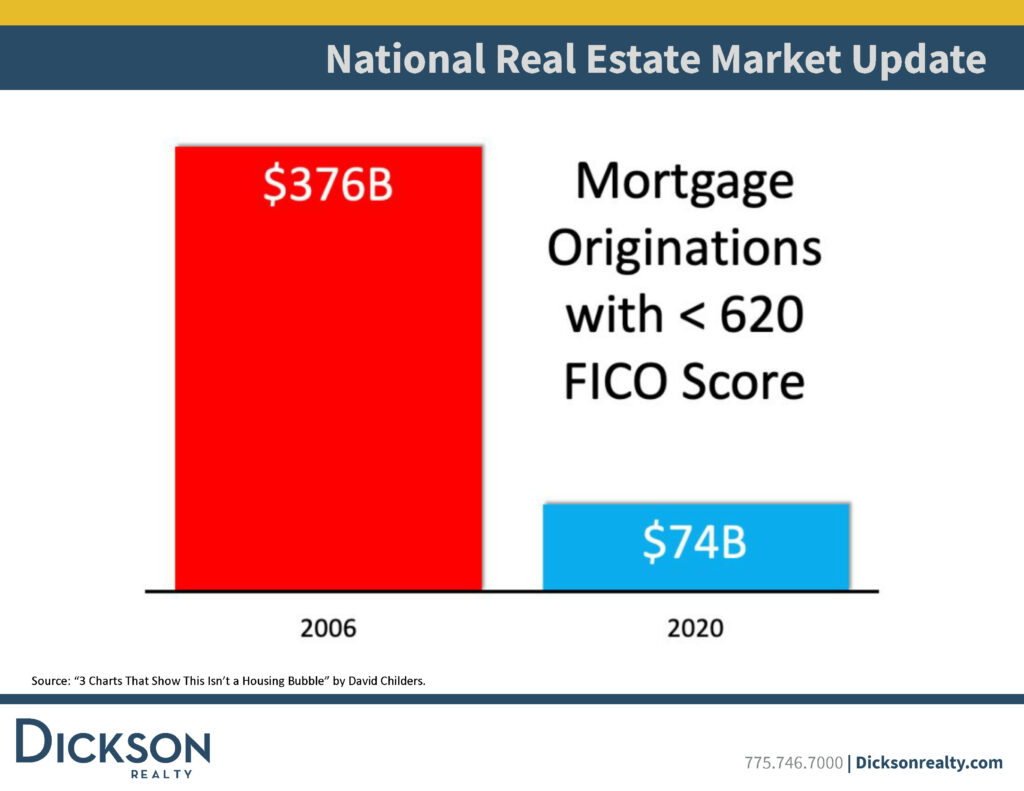 Risky loans, lenient underwriting, and lack of regulation in the mortgage industry fueled a significant part of the 2008 Great Recession and housing crisis. In response, financial regulatory reform resulted in about an 80% decrease in mortgage origination for individuals with less than a 620 FICO score. Because these regulations made it more challenging to get a mortgage in the years following the Great Recession, individuals who did receive a loan demonstrated excellent credit and other qualifications. As a result, buyers who qualified for a mortgage to purchase a home since the Great Recession were not buying on speculation and were on more secure financial footing.
Risky loans, lenient underwriting, and lack of regulation in the mortgage industry fueled a significant part of the 2008 Great Recession and housing crisis. In response, financial regulatory reform resulted in about an 80% decrease in mortgage origination for individuals with less than a 620 FICO score. Because these regulations made it more challenging to get a mortgage in the years following the Great Recession, individuals who did receive a loan demonstrated excellent credit and other qualifications. As a result, buyers who qualified for a mortgage to purchase a home since the Great Recession were not buying on speculation and were on more secure financial footing.
-
Homeowners have more equity
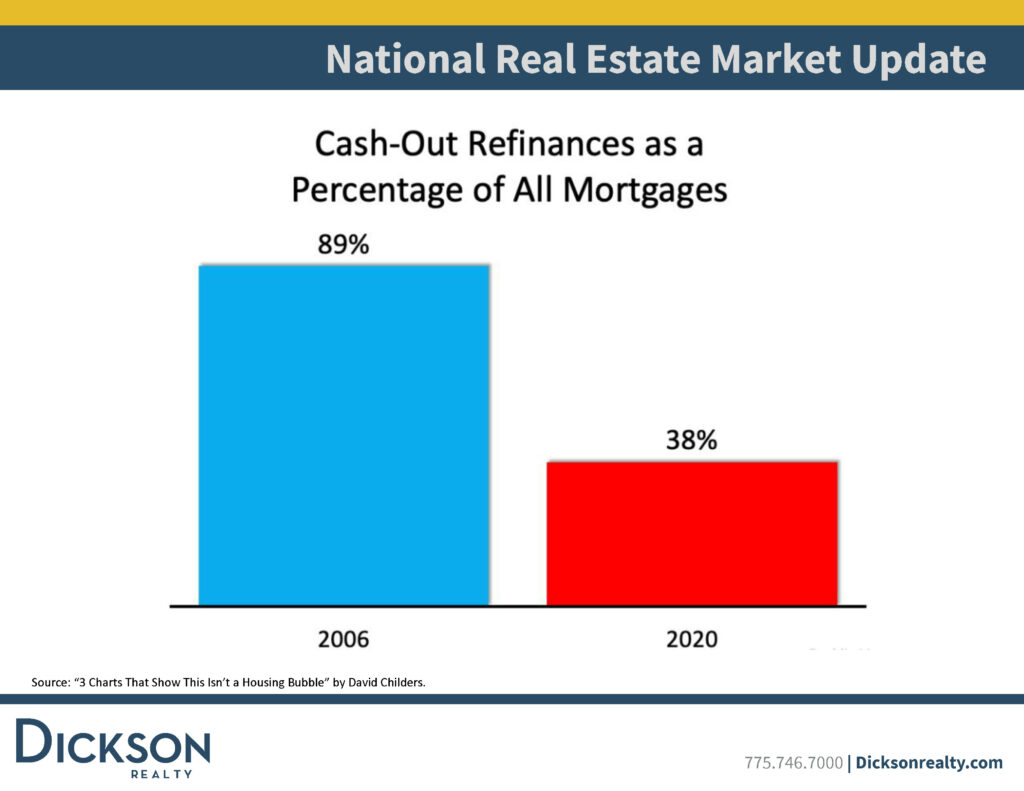
People have more equity now in their homes than they did before the Great Recession. In 2006, 89% of refinancing loans were cash-out refinances, meaning that people were taking cash out, and for the most part, speculatively buying more property rather than improving their current home. So far in 2021, only 38% of refinancing loans are cash out, and homeowners are using those funds to improve their current home and increase its value. This trend coupled with appreciating home values means that people have enough equity to sell their home, pay off their mortgage and fees, and retain some of the money from the sale. This is likely true for individuals who may be in mortgage forbearance due to the COVID-19 pandemic. So, even when the foreclosure moratorium on federally backed mortgages expires, if homeowners do need to sell their home, most can do so and walk away with cash in hand.
-
Builders need time to catch up with demand
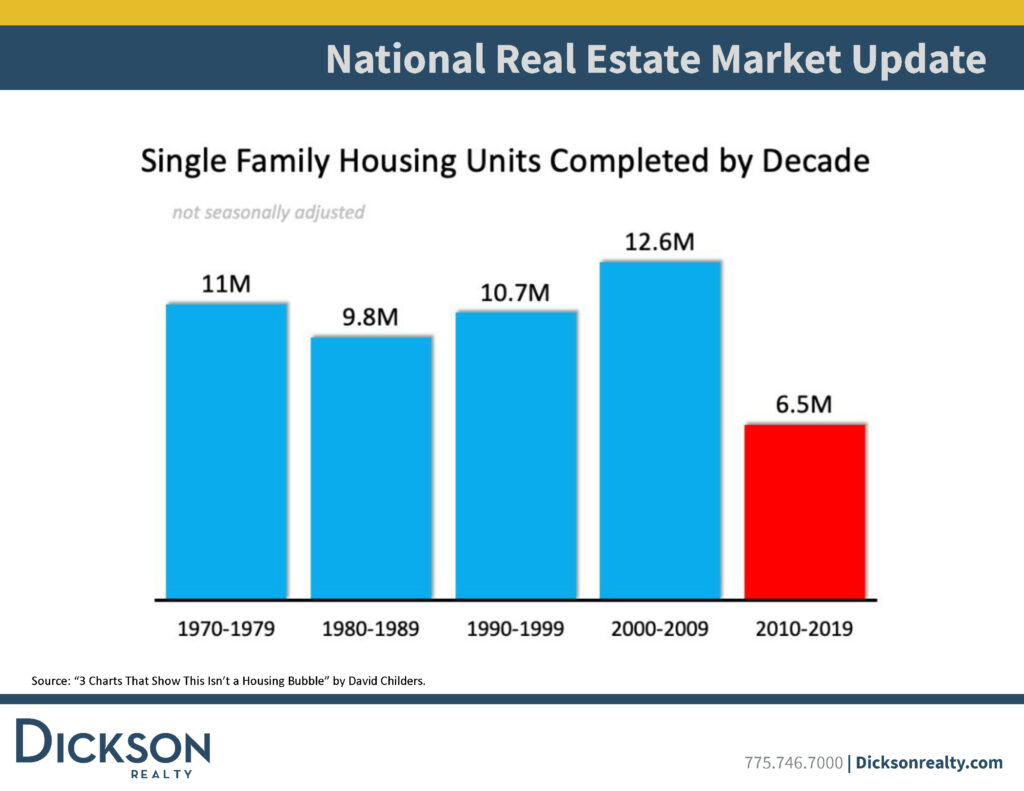
The current market for newly built homes reflects decisions made years ago. From 2010-2019, only 6.5 million homes were built nationwide—half of what was built in the previous decade. The slowdown in building reflected a decrease in demand and buyers due to the Great Recession. However, in the last five to six years, demand has increased for new homes, and the COVID-19 pandemic sent a shockwave through the system. There are not enough new homes being built to keep up with population growth and demand, especially as people seek to buy homes as a reaction to the pandemic.
How National Trends Affect The Reno-Sparks Real Estate Market
Housing supply increases
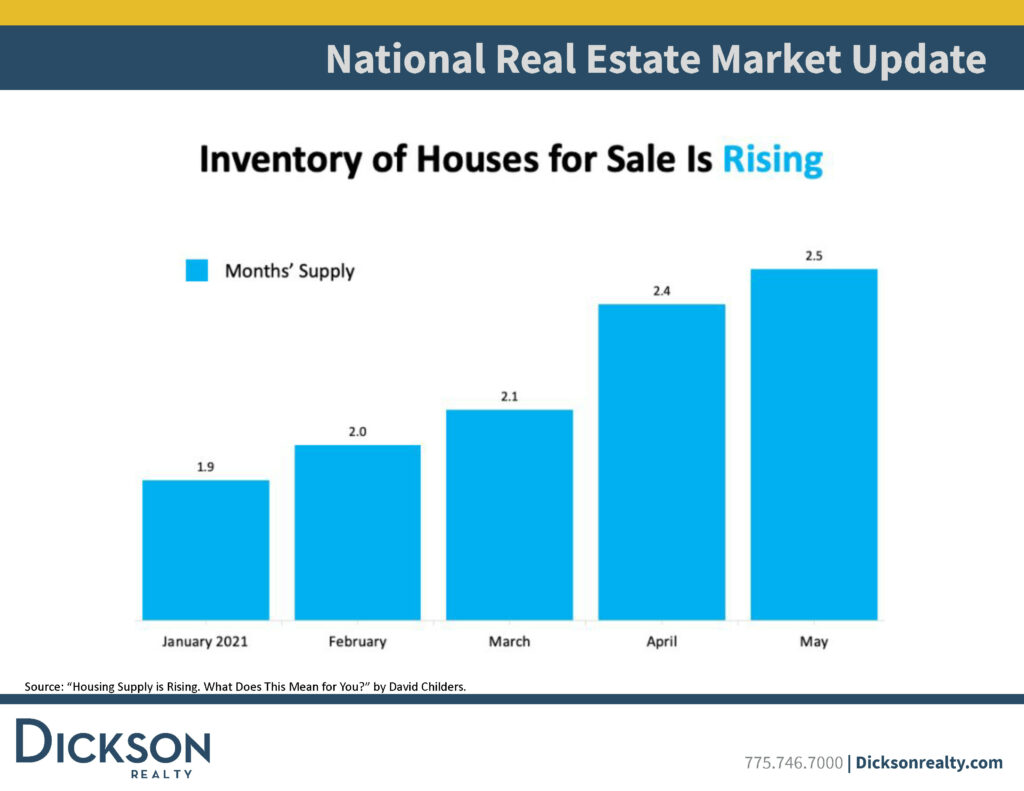
Nationally housing supply is increasing, which will bring down the market from an extremely hot market to just a hot market. In January 2021, the national inventory of homes for sale was measured in 1.9 months. Months or days of inventory is how REALTORS refer to the amount of time it would take to sell all existing homes for sale if no additional homes entered the market. A balanced market has six months of inventory, representing buyer demand and seller inventory. By May 2021, the national inventory rose to 2.5 months, which, while still relatively low, is a marked improvement. We want to see a more balanced market, as it benefits both buyers and sellers.
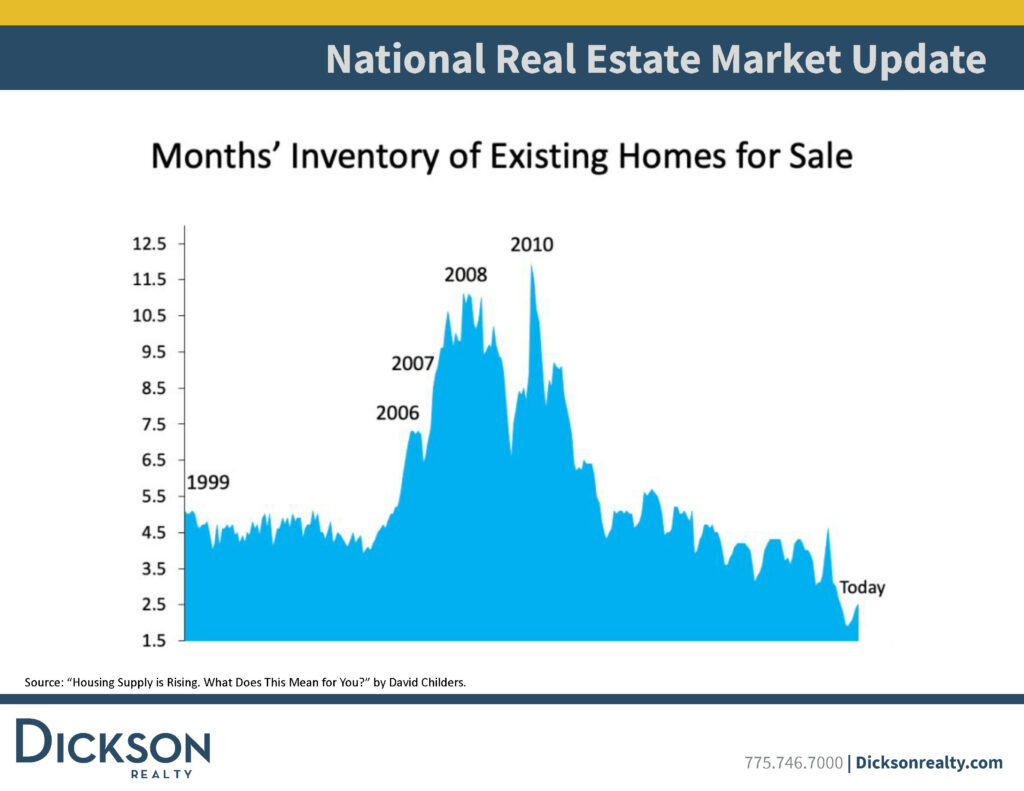
Mortgage rates decline
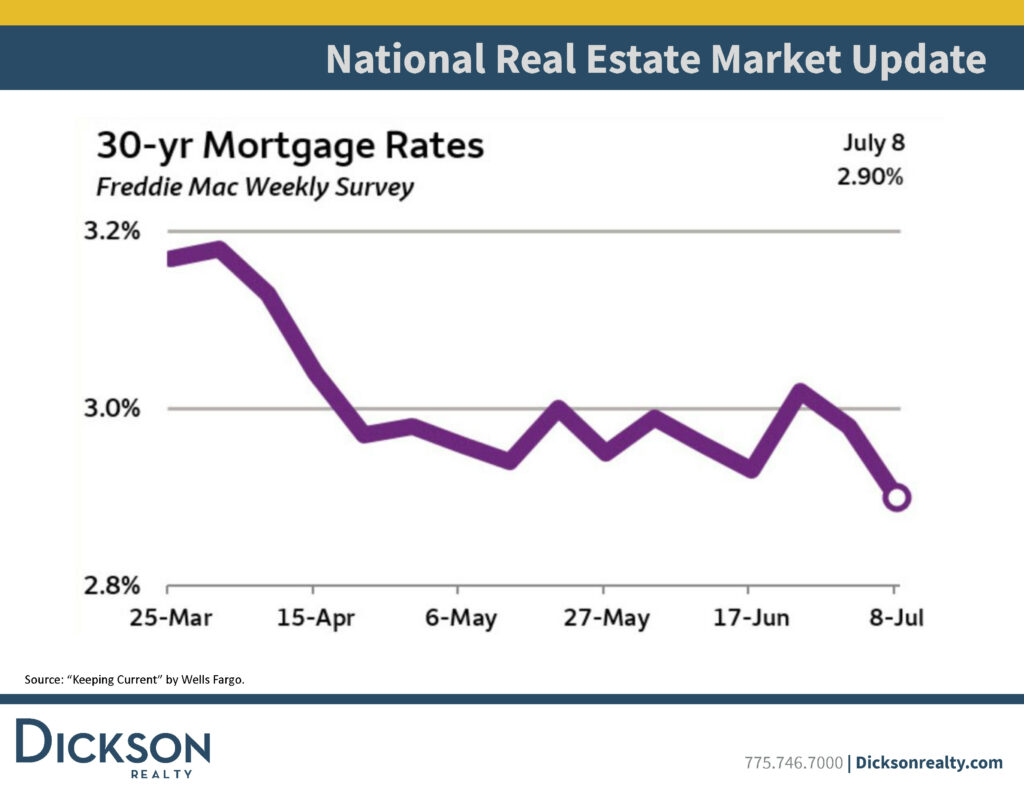
Mortgage rates always impact the housing market nationally and locally. Since late March, rates have declined, allowing buyers to afford higher-priced homes. Mortgage rates will likely increase over time, which would curb the appreciation of home prices as buying power goes down. That’s not a bad thing. It’s healthy to see a slight slowdown in the appreciation of prices to create a more balanced market.
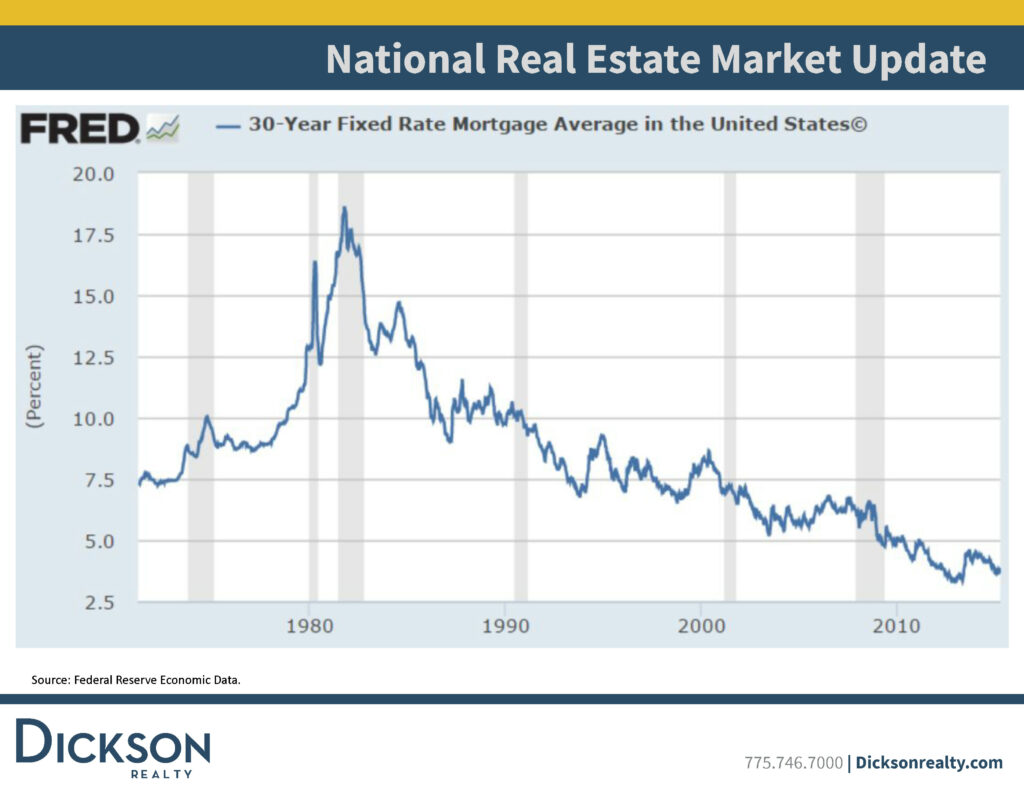
Appreciation rates predicted to slow—eventually
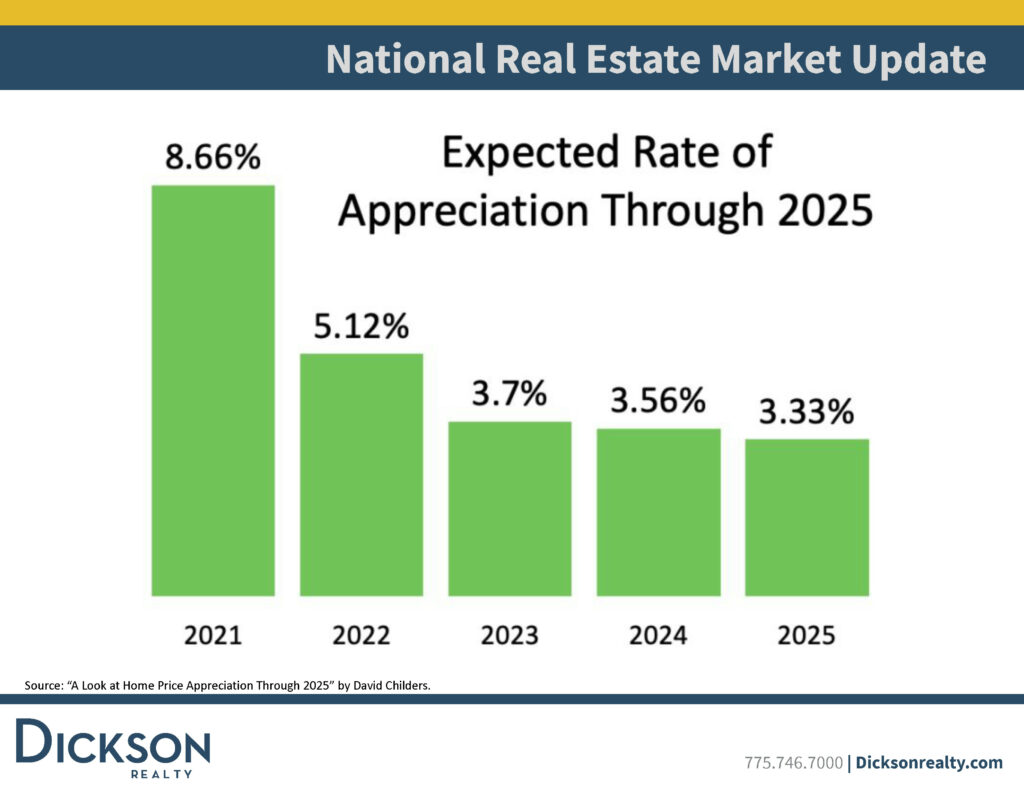
In 2021 already, home prices nationally are expected to appreciate by 8.66%, or more than 2% per quarter, according to David Childers, vice president at Keeping Current Matters, who tracks real estate market statistics and economics. In a healthy and balanced housing market, we typically look for a 1% appreciation every quarter. According to Childers’ predictions, home price appreciation will slow over the next five years, reaching 3.33% by 2025.
Reno Real Estate Trends: Local Stats To Know
Median sales price increases from May to June
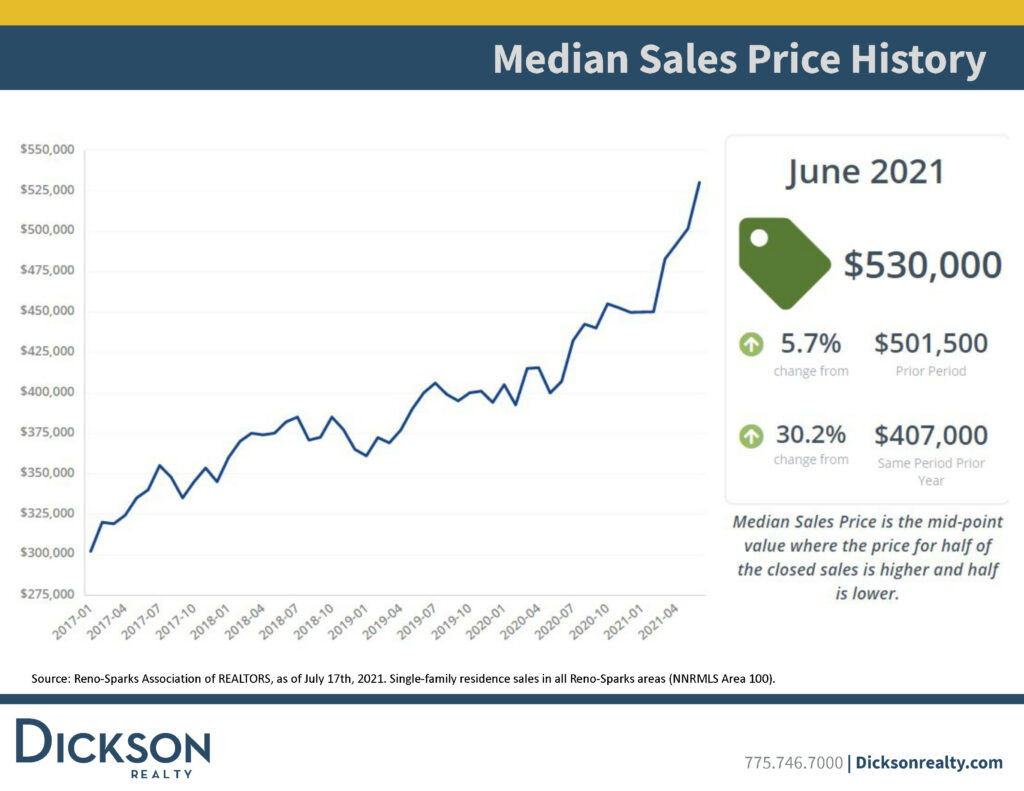
In June 2021, the median sales price of a home in the Reno-Sparks area grew to $530,000, breaking the record-breaking $500,000 recorded in May 2021. That’s an increase of 5.7% month-over-month and 30.2% year-over-year. The median home price has increased by 16% so far in 2021, which is about equivalent to 2.5% per month. This is dramatic growth, and we may see this pace start to slow in the coming months.
Over ask analysis stays steady
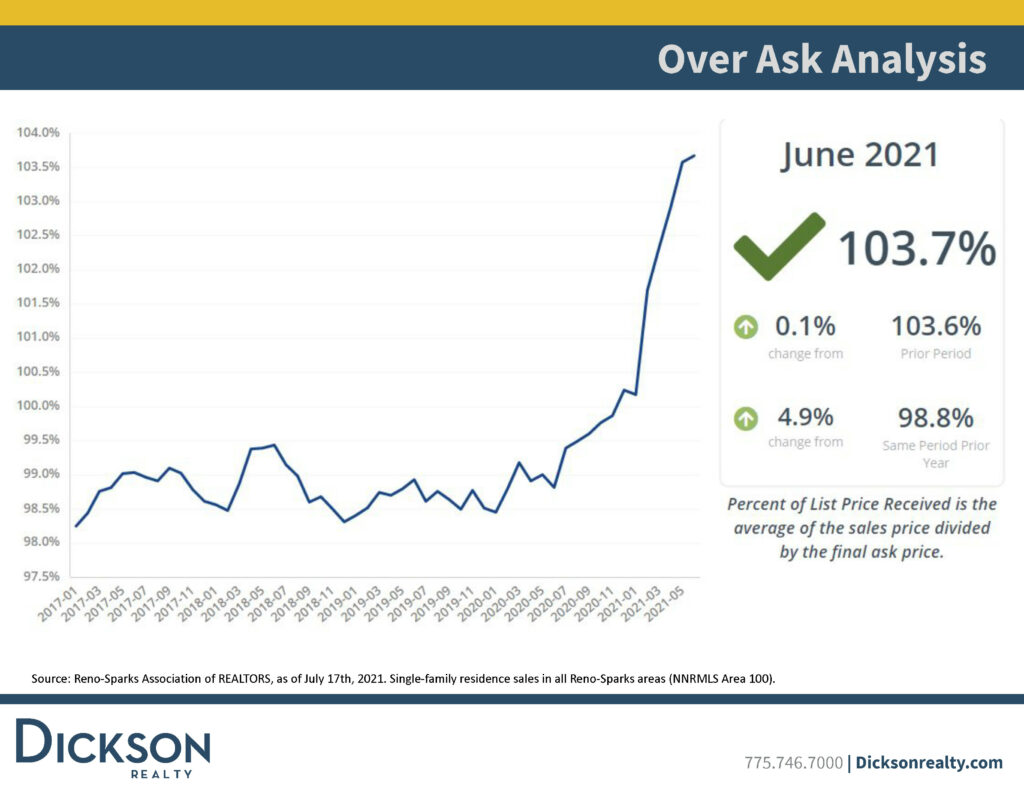
To understand how many offers sellers receive and if those offers are above the original list price, our Dickson Realty agent Amy Shocket has created this over ask analysis. It shows the average percentage of over ask offers that are coming on the market. In June 2021, this average held steady at 103.7%, up 0.1% May 2021. Anecdotally, our agents observe that homes are staying on the market just a tad bit longer before selling. We don’t have as many offers, which means the competition is slowing. So, we’re not getting as high of over asking prices.
Supply remains constant
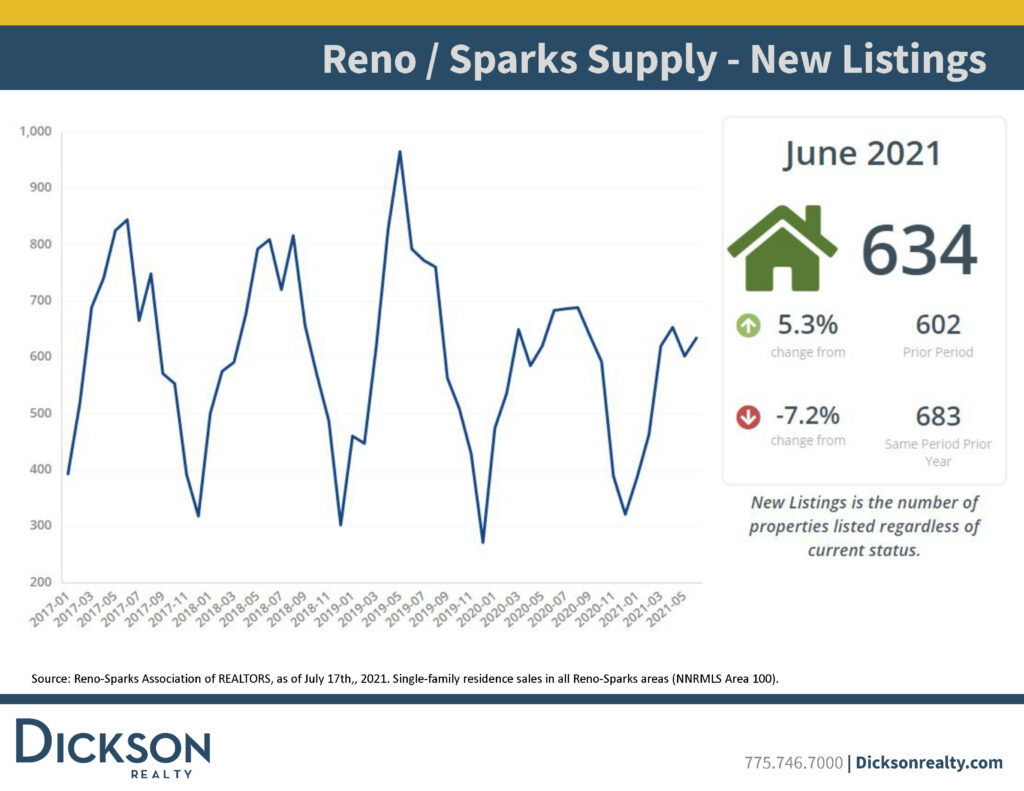
New listings coming into the market for June 2021 were 634, up 5.3% from May 2021. As of late July 2021, there are 362 homes available for sale in Reno, down about 50% from July 2020. But our standing inventory is up 35% from June 2021, another indicator that the market is slowing a bit.
New contracts continue trend
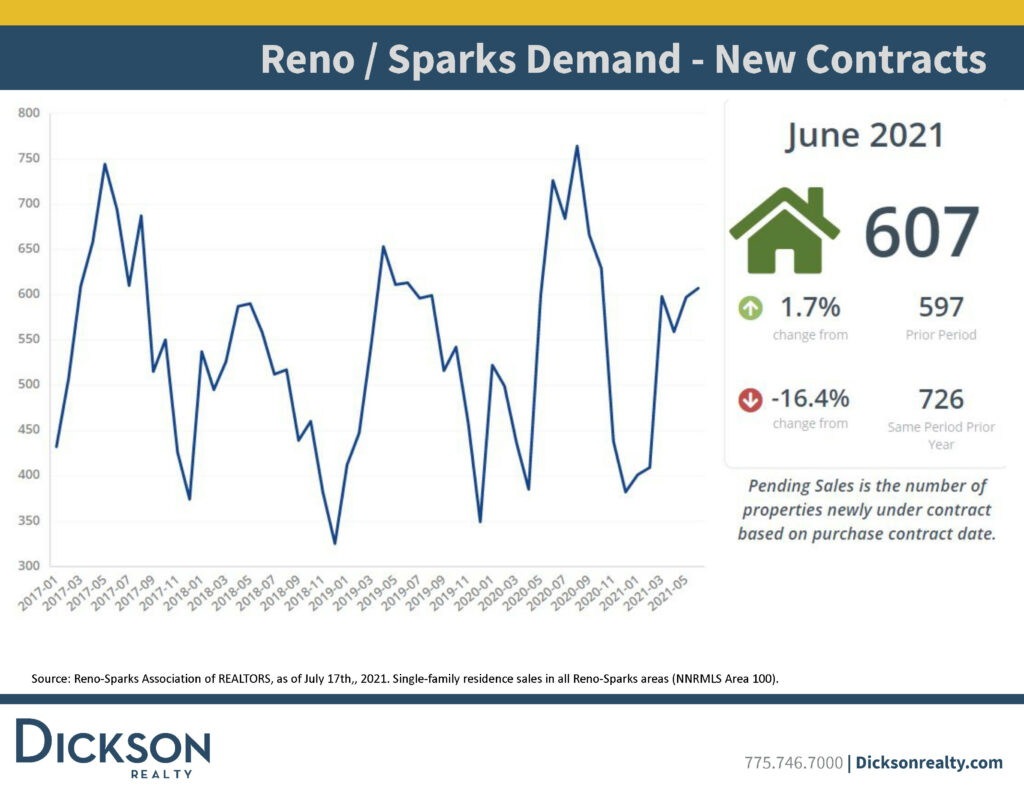
The number of new homes under contract demonstrates the demand in the market, which is holding steady. In June 2021, there were 607 new contracts, up 1.7% from May 2021 and down 16.4% from June 2020. However, this decrease is consistent with the increased demand we saw in 2020 as people came out in droves to buy real estate.
Units sold increases
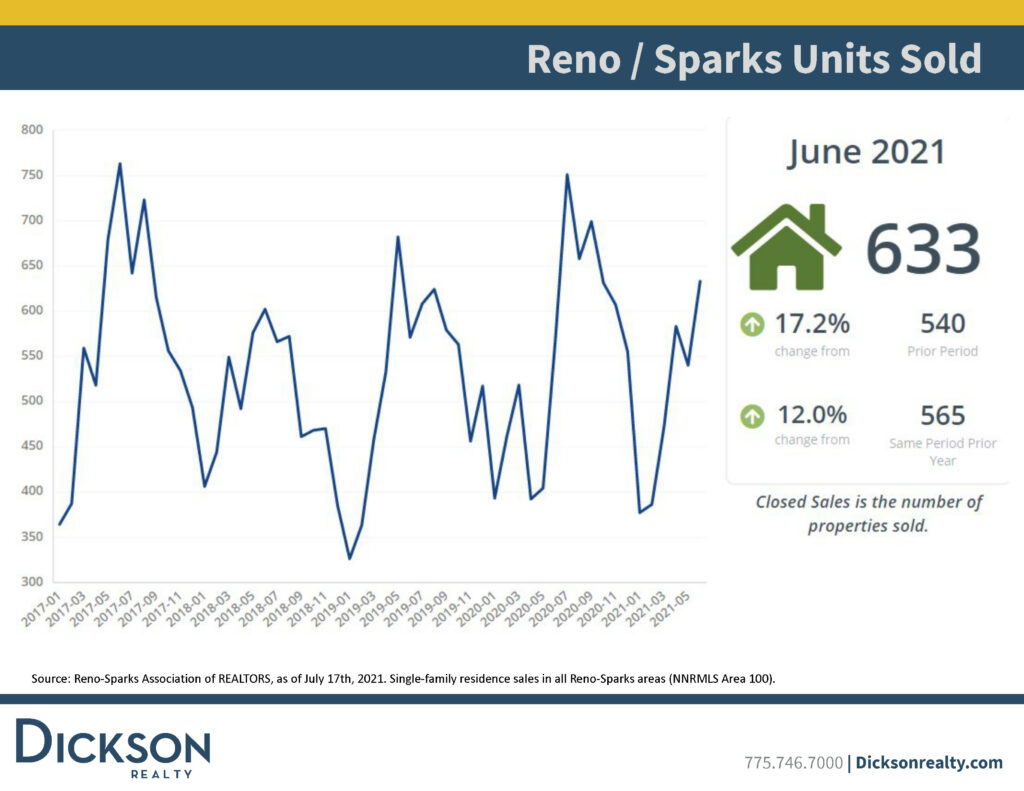
In June 2021, the number of units sold increased by 17.2% month-over-month and 12% year-over-year. This growth demonstrates that while standing inventory is low, there is still enough supply to fueling an increase in sales.
Days on market
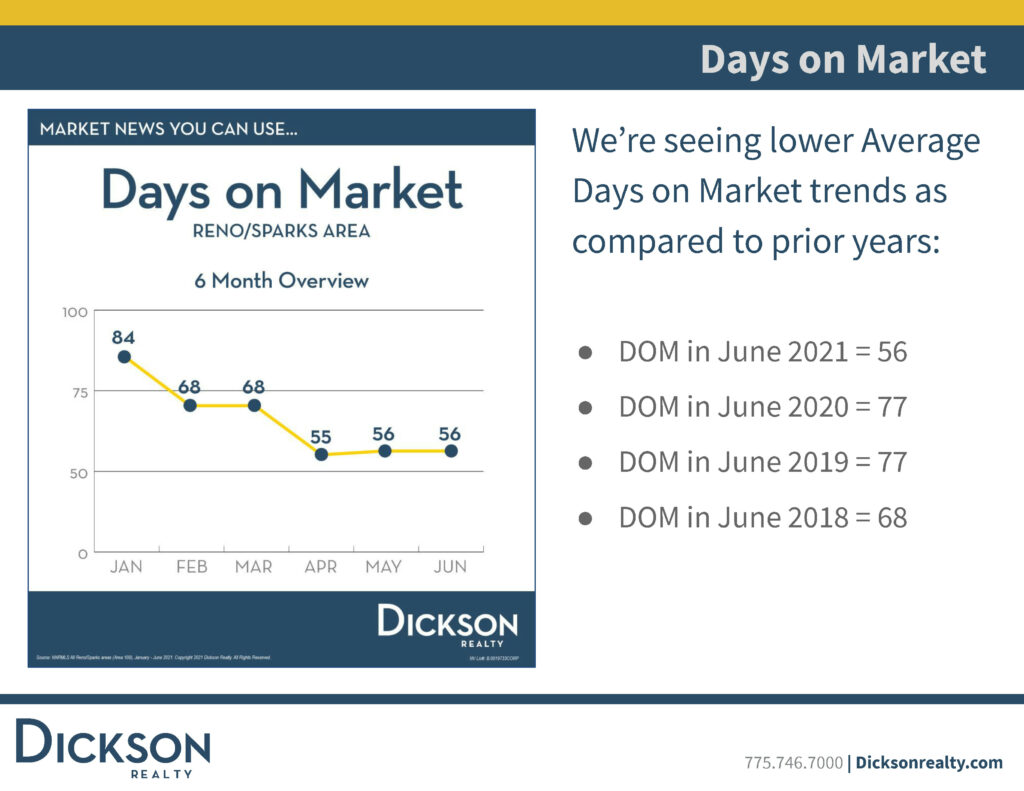
Days on the market also kind of show the speed or the velocity of the market. As of June 2021, homes for sale in the Reno-Sparks market stayed on the market for 56 days before selling.
Reno Real Estate Trends: Our #1 Takeaway
After carefully analyzing local and national trends, we believe that there may be a bit of a slowdown coming to our market, but that is good. We want more of a balanced market.
What to do with this information…
Sellers
If you’re thinking about selling your home, now is the time to take advantage of high demand and fast market times. The increase in standing inventory can be a benefit if you’re concerned about finding a new home to live in once you sell your current property. An expert agent can help you navigate the various options available to you. Our Dickson team can help you sell your current home and find a new home while minimizing the disruption to your life.
Buyers
Don’t hold out false hope for a market crash to bring down home prices. Instead, be prepared to enter the market with your ducks in a row so you can quickly make an offer on the home you love. While we may be seeing a very slight softening in market conditions, having a pre-approved mortgage and an experienced Realtor by your side can make all the difference.



